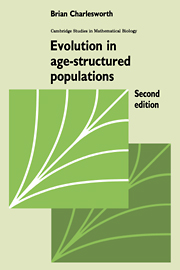Book contents
- Frontmatter
- Contents
- Preface
- Preface to the second edition
- 1 Models of age-structured populations
- 2 The genetics of populations without selection
- 3 Selection: construction of a model and the properties of equilibrium populations
- 4 Selection: dynamic aspects
- 5 The evolution of life-histories
- Appendix 1 Generating functions and their properties
- Appendix 2 Asymptotic values of ρpi and 2ρi
- References
- Author index
- Subject index
1 - Models of age-structured populations
Published online by Cambridge University Press: 18 December 2009
- Frontmatter
- Contents
- Preface
- Preface to the second edition
- 1 Models of age-structured populations
- 2 The genetics of populations without selection
- 3 Selection: construction of a model and the properties of equilibrium populations
- 4 Selection: dynamic aspects
- 5 The evolution of life-histories
- Appendix 1 Generating functions and their properties
- Appendix 2 Asymptotic values of ρpi and 2ρi
- References
- Author index
- Subject index
Summary
Introduction
The populations of many species of plants and animals are age-structured; if such a population is investigated at a given point in time, it is found to consist of a set of individuals who were born over a range of past times, and whose fecundities and probabilities of future survival depend on their age. The human population is an obvious example. A full ecological description of the state of such a population should therefore take into account the relative numbers of individuals of different ages (the age-structure of the population), as well as its overall size. Similarly, a description of the genetic composition of the population should contain a classification of individuals by age as well as genotype. The traditional theories of ecology and population genetics have, however, usually ignored the problem of age-structure, and have assumed that populations can be treated as homogeneous with respect to age. This is clearly legitimate in dealing with organisms with discrete generations, such as annual plants, where only individuals born in the same season are capable of interbreeding. Many species of biological importance have overlapping generations, however, and their fecundities and survival rates are rarely completely independent of age, so that their age-structure should be taken into account in any realistic model of their behaviour.
There has recently been considerable interest in extending ecological and population genetics models to include age-structure as a variable. Evolutionary theorists have also become interested in the role of natural selection in moulding the way in which fecundity and survival depend on age. The purpose of this book is to give an account of the major results which have been obtained by applying ecological and demographic models of age-structured populations to population genetics and evolutionary theory.
- Type
- Chapter
- Information
- Evolution in Age-Structured Populations , pp. 1 - 61Publisher: Cambridge University PressPrint publication year: 1994
- 4
- Cited by



